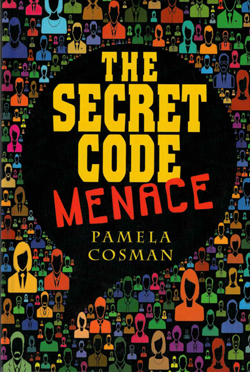The Secret Code Menace by Pamela Cosman; Ransom Publishing Ltd; United Kingdom; (c) 2016; ISBN 978 178127 976 2; 200 pages.
By Donald H. Harrison

 SAN DIEGO — Author Pamela Cosman teaches electrical and computer engineering at the University of California San Diego. But in The Secret Code Menace, Cosman, a member of San Diego’s Jewish community, tries her hand at teaching code messaging theory to fourth graders. Her fictional story instructs young readers in ways to interpret a coded message from a friend even if a third party tries to disrupt the communication.
SAN DIEGO — Author Pamela Cosman teaches electrical and computer engineering at the University of California San Diego. But in The Secret Code Menace, Cosman, a member of San Diego’s Jewish community, tries her hand at teaching code messaging theory to fourth graders. Her fictional story instructs young readers in ways to interpret a coded message from a friend even if a third party tries to disrupt the communication.
Cousins Daniel and Sara are almost inseparable, so much so that they have developed a way of communicating 16 common thoughts, such as ‘I’m happy’ or ‘I’m angry at someone’ through binary number sequences. The fun in this story starts when the teacher isn’t looking and Daniel sends to Sara a note with the numbers 1111 on it, meaning “Come to my house later.” Passed from pupil to pupil it finally arrives at the desk of Sara, who jumps up and loudly starts singing “Mary Had a Little Lamb.”
What happened was that someone sitting between Daniel and Sara had changed the bit sequence from 1111 to 1110. The latter code meant “diversion needed.”
This led to Sara being sent to the principal’s office, and to the two cousins beginning a quest to learn how they could protect themselves in the future from such a mishap. Their first step was to elongate their codes, converting every digit, or bit, in the original code to three bits. Thus 1110 became 111111111000. If anyone should change a single bit, it would break the pattern of three identical bits, and the recipient would know that the message had been tampered with.
But suppose Daniel and Sara wanted a system that could not only detect an error, but also correct it? In the book, they learn to do that.
Cosman has not simply prepared a book of instructions, however. Young readers will follow Daniel and Sara as they try to decide what lunch club they should belong to, what games and projects they enjoy in those clubs, and finally they will see how Daniel and Sara apply their knowledge when confronted by a real life crisis.
For grandparents like myself who may have missed learning the basics of computing, such as how to write code, this book provides us some insight. And after reading it with our grandchildren, if we are still confused, we can always ask them to re-explain it to us!
*
Harrison is editor of San Diego Jewish World. He may be contacted via donald.harrison@sdjewishworld.com. Comments intended for publication in the space below MUST be accompanied by the letter writer’s first and last name and by his/ her city and state of residence (city and country for those outside the United States.)